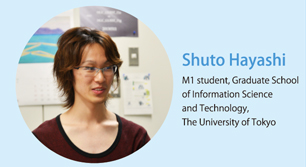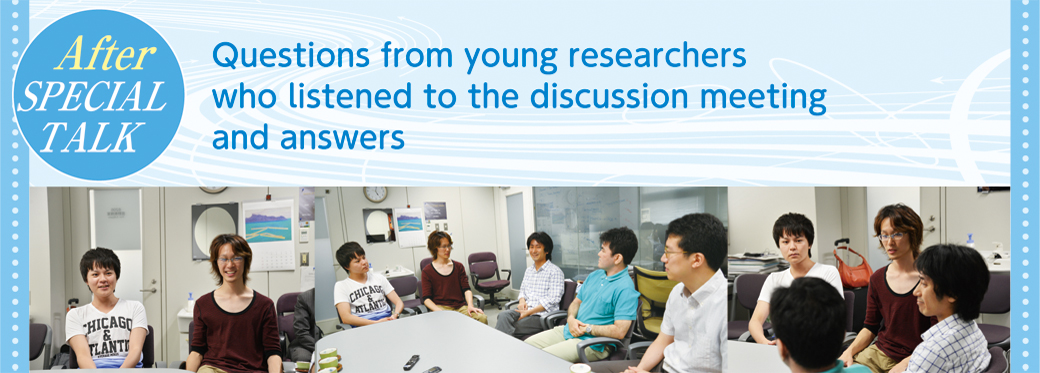

What I was keenly impressed from this interview is an aggressive attitude to understand the field integrating the area which they do not major in. As they say 21st century is the age of science, bioscience is still wrapped in mystery. Therefore, necessity of cross-sectional approaches such as bioinformatics and system biology has been emphasized. Though this area, in which fruitful research challenges providing biological discovery and computational novelty cannot be found without detailed knowledge of both bioscience and information science, is very nerve-wracking for students like us, I think that’s why it is interesting and I’m proud to have chosen it as area of study. After I finished my degree, I think I spend some time away from bioscience and become a researcher of statistical learning theory to contribute to the development of information science technology. Also in the field of statistical learning theory, I would like to hold a respect in the attitude to take active interest in various fields of study I learned here, and I strongly want to become a full-fledged researcher.

Thank you for giving us an opportunity to hear the important ideas of researchers. I want to become a researcher, so today’s talks are very beneficial to me. One of the reasons for entering the field of bioinformatics is the fun of analyzing a very complicated system of life by using the knowledge of information science. Analysis of complicated system requires a complicated model which captures the structure of the system, so HPC is essential. When we can obtain more accurate data thanks to technological development and use exa-scale supercomputer in the future, I think we will be able to capture more complicated life-phenomena. Therewith more sophisticated theory and model will become necessary. I want to be a researcher who leads such a leading-edge and frontier studies.
【Hayashi】 How did you find your study themes?
Niida Besides the fact that I wanted to study the theme, encounters with people had a great impact on me. I joined the K computer project because I came to the Miyano Lab. Encounters with in-service physicians also led me to the study theme. People can get interesting ideas by meeting others.
Ito I wanted to basic science, and bioinformatics happed to be there.
Kakuta My theme gradually materialized as I read papers and talked with people in congresses. Any theme should be appealing at least to the person who studies it, but what appeals may differ depending on the person.
【Chikahara】 I’d like to ask Dr. Niida. I think not only the amount of data but also the kind of data available is increasing along with the progress of computational science and measuring technologies in life science. Did you find anything interesting among them?
Niida I’m interested in a single cell sequence. Sequence data is now obtained by sampling groups of cells from parts of a tumor and sequencing their DNAs. A technology is rapidly being developed for extracting DNAs from a single cell and reading the DNAs. The technology will make it possible to obtain a huge amount of data from one single cancer cell. Instead of doing simulation calculations by varying parameters, we will be able to perform better simulation by fitting the large amount of data in the simulation and assimilating the data. It is possible that the technology will lead us in such a direction.
【Chikahara】 You said that handling the K computer is a rather high hurdle for a biologist. What are the difficult points, actually?
Ito For example, parallelization is one of the difficult points and so is optimization. Most of them aren’t difficult if you have the knowledge, so I recommend you to find a person or persons who have that knowledge and information, say “I want to do such and such”, and ask for advice.
【Chikahara】 Thank you very much. I’d like to ask Dr. Kakuta something. What discoveries have been made by determining the genomic percentages of microorganism species in the environment or in the human body?
Kakuta It’s not one of my studies, but it has been reported that the percentages of certain microorganism species differ between a healthy person and a person who has a specific disease. We still don’t know which is the cause and which is the result, but the relationship has been revealed. It is possible that we will be able to detect a disease or predict its onset from the level of specific species.
Niida Also in cancer, not only the genome of the cancer cells but also the metagenome surrounding the cancer are suspected to be involved. For example, the involvement of Helicobacter pylori in stomach cancer is well known. We may obtain interesting results by studying the metagoneme surrounding a cancer together with the genome of the cancer cells.
【Hayashi】 I think we should comprehensively analyze not only the metagenome but also the RNA-seq, ChIP-seq and so on, but what computational resources do we need for such an analysis?
Niida We need even larger computational resources than what we have now, but it is more important to make it easy for biologists and people in related fields to use and process diverse kinds of data. Resources are needed, but the interface is also very important.
Ito What we want from a sequencer is not a DNA sequenceing data itself but basically to detect any variation. In this sense, when bioinformatics is a bit more advanced and databases such as reference genomes are complete, we will possibly be able to detect diseases by comparing the data from a sequencer with the data in a database of variations with no computation. We will not need a supercomputer but only a sequencer.
【Chikahara】 You said you are having trouble transferring big data. Will you continue to have trouble?
Ito Supercomputer development has always pursued CPU speed. It has been highly inclined toward CPU performance compared to other aspects, such as the performance and size of storage and memory capacity. This has been a global trend and not only in Japan, but everybody started to realize that we need a balanced machine, and to appropriate resources also to other aspects. In this sense, I have expectations about its future development. On data transfer, I’m negotiating so that we can download data directly to the storage of the K computer. I’m asking the operation side for flexibility, and the work of data transfer will be sharply reduced by that. I’m not pessimistic at all.
【Chikahara and Hayashi】 Thank you very much for sharing your valuable ideas.

















